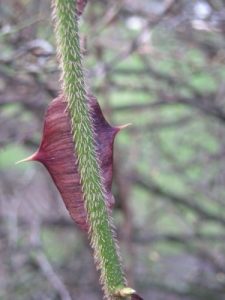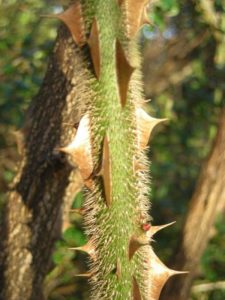Rosa sericea ssp. omeiensis forma pteracantha – the longest sequence of names and the most decorative of thorns are this plant’s claim to fame. As there was no possibility of finding a bunch of twelve red roses in bud in the Garden, this species will have to suffice representing St Valentine’s Day.
R. sericea has a distribution range through the Himalayas into south-west and central China. Our specimens were collected on the Sichuan expedition of 1997.
As can be seen from the two images, the broad, flattened spines are variable in colour, shape and size. In colour they vary from near translucent to a dull brown through many attractive shades of red. The stems are often populated with a multitude of small spines.
This strong-growing rose is best pruned to allow young shoots to regenerate from the base of the plant – the young wood produces the best stem and spine colour. As the wood ages, the colours depreciate in their intensity.


